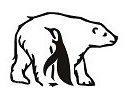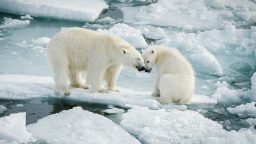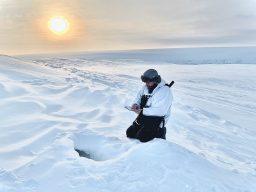
Nuclear icebreaker
Polar territories. Economics and Science
18% of the entire territory of Russia is located beyond the Arctic Circle. Only about 2% of the population lives here. Nevertheless, the region provides 11% of GDP.
A significant amount of minerals is mined here. But this region can give even more in the future: 25% of the world’s oil and gas reserves are located here, as well as rich deposits of gold, mercury, tin, silver, manganese, chromium, and titanium. 15% of the Russian catch of fish and seafood is in the Arctic, and in the near future this figure will only grow.
The Northern Sea Route (NSR) plays a separate role for the Russian economy. Currently, essential goods for the cities of the Arctic coast are transported along the NSR highway. Often, the only alternative to such supplies is expensive air transportation. The life of 29 regions of Russia depends on the NSR. The changing climate and the reduction of ice increases the navigation time on the NSR and reduces the cost of transportation.
In 2022, the NSR development plan was approved until 2035. In the same year, the volume of cargo transportation along the Northern Sea Route amounted to 34 million tons, according to forecasts, in the coming years, the volume of transportation along the NSR may grow to 80 million tons.
As for Antarctica, this is still a work for the future. Up to 90% of the world’s freshwater reserves are concentrated on the southern continent. Deposits of coal, iron ore, polymetallic ores, precious and rare earth metals have been discovered there. The total volume of hydrocarbons located on the shelf of the Antarctic seas is estimated by experts from 35 billion to 51 billion tons of conventional fuel.
Observations of climatic and meteorological processes in the Arctic and Antarctic have shown that they are a climate-forming factor for the entire planet. Scientific observations in these regions make it possible to make more accurate weather forecasts, discover the laws of climate formation and ocean currents, make long-term predictions of temperature changes on Earth, and ice melting.
The southern continent and the Arctic are covered with ice, which store the most valuable information about the Earth’s past, being a man-made archive of climate change and precipitation. Studies of subglacial lakes in Antarctica will shed light on the formation of life on the planet, expand our knowledge about the possibility of life to exist in extreme conditions.
The Arctic. Signs of warming

The Arctic
In September 2022, the first ice-resistant self-propelled platform “North Pole” went on its maiden voyage. This became the most important event for the study of the region: the program of drifting stations has been on pause since 2013 due to the melting of ice in the Arctic. It has become unsafe to place stations on ice floes, as it was done before.
The new platform is a huge vessel with a scientific complex of 17 laboratories, a fleet of transport equipment, a helicopter pad and everything necessary for the comfort of polar explorers. It can freeze into an ice floe and drift for up to two years.
Over the past year, the station has traveled over 3,200 km, conducted more than 50 different studies and received a lot of information about the natural environment of the Arctic and hydrometeorological processes. The vessel will drift, presumably, for another three to four months, after which it will enter ice-free waters and set a course for Murmansk. The next expedition is scheduled for the end of summer 2024.
Warming is underway — a very complex and ambiguous process for Russia. On the one hand, shipping time is increasing, the forest area is growing, and many crops can be grown further north. On the other hand, this leads to the extinction of traditional flora and fauna and the melting of permafrost in the Arctic region, which is accompanied by massive methane release. Scientists have yet to answer questions about the causes of climate change. Further research is needed for this.
Antarctica. Life at low temperatures

Antarctica region
Today, there are five permanent domestic stations in Antarctica, research is conducted from research vessels.
One of the largest projects in recent years is the construction of a new winter complex for the Vostok station. Three of the five modules have already been assembled, and more than 3 thousand tons of construction cargo have been delivered here. The complex should be ready next year. 35 scientists will be able to live and work in comfort there. The station will conduct scientific research on the climate and gas composition of the Earth’s atmosphere over the past one and a half million years. These studies will be a continuation of the scientific program started earlier.
The analysis of ice and snow deposits near the Vostok station has already allowed us to find out how the climate in Antarctica has changed over the past 2,200 years. It turned out that until the beginning of the XIX century, there was a slight cooling and a decrease in the rate of snow accumulation in the area of the subglacial Lake Vostok. But in the next 200 years, the situation changed — the rate of snow accumulation began to grow, and the temperature growth rate was 1.6 °C per year.
Large construction projects do not reduce the intensity of Russian research in Antarctica. Of the latest discoveries, there are 18 lakes near the Russian station. It turned out that reservoirs above 85 m above sea level are fresh, and below — salty. Most of the lakes turned out to be frozen, but others had water under the ice. Low temperatures do not interfere with life. The lakes turned out to be previously inhabited.
Russia’s Arctic fleet is also developing. In August, the construction of the largest scientific research vessel Ivan Frolov began at the Admiralty shipyards. This is a five-in-one vessel: tanker, icebreaker, passenger, cargo and scientific vessel. It will house 20 scientific laboratories, as well as a helipad that will be able to receive Mi-8, Mi-38 or Ka-32. “Ivan Frolov” will be able to deliver cargoes and groups of polar explorers up to 170 people and land an expedition even on an unequipped shore or ice.
RBC
More amazing facts about the Arctic can be read here.


